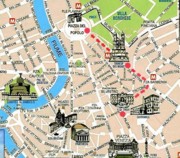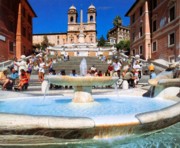
ROME WALKING TOUR WITH GUIDE (TREVI FOUNTAIN + PIAZZA DI SPAGNA + PIAZZA DEL POPOLO) FOR DISABLED
Details
ROME – Guided Walking Tour (Trevi Fountain + Piazza di Spagna + Piazza del Popolo) for disabled – 2 hours
|
DURATION: | 2 hours | |
|
PRICE: | View the price list | |
|
AVAILABILITY: |
All-year-round |
THE PRICE INCLUDES: |
English-speaking Guide for the 2-hour tour of Rome |
This tour route, designed specifically for the disabled, is completely step-free.
You’ll meet our professional English-speaking guide in the prearranged meeting-point, which can be changed according to guests requirements.
We will start the marvellous tour of Rome by visiting the Trevi Fountain., Rome’s most sumptuous.
Of course, you have to toss a coin in the Trevi. To do it properly (Romans are superstitious), hold the coin in your right hand, turn your back to the fountain, and toss the coin over your left shoulder. According to traditions, the spirit of the fountain will then see to it that you return to Rome one day.
Next stop is the Piazza di Spagna and the Spanish Steps rising from the piazza are the meeting place of Rome. In spring, the steps are decorated with colourful azaleas, but in any season the square is atmospheric – though you can hardly see it when it’s covered with wall-to-wall tourists, lovers, backpackers, Roman youth, and so on. The atmosphere is festive and convivial, though. The piazza’s name comes from the 15th century, when the Spanish ambassador made his residence here. In those days, the piazza was far less hospitable (People passing through the piazza at night sometimes disappeared. Because it was technically Spanish territory, the unwary could be pressed-ganged into the Spanish army). The area’s most famous resident was English poet John Keats, who lived and died in the house to the right of the steps, which is now the Keats-Shelley House. The real name of the steps isn’t the Spanish Steps but the Scalinata della Trinità del Monte, because they lead to the Trinità del Monte church, whose towers loom above. At the food of the steps, the boat-shaped fountain by Pietro Bernini, father of Gian Lorenzo, is one of the most famous in Rome.
Finally we’ll reach the vast, architecturally superb and perfectly symmetrical Piazza del Popolo which was designed by Valadier at the beginning of the 19th century. At the centre is the second Obelisk brought to Rome by Augustus, which was erected here by Fontana during the papacy of Sixtus V.
The church of Santa Maria del Popolo is one of the most interesting in Rome. Probably first built in the 11th century, it was completely reconstructed in the early Renaissance. Among the many works of art worthy of attention are: the Adoration of the Child by Pinturicchio, above the altar of the first chapel on the right; two monuments by Sansovino on either side of the high altar: to Cardinal della Rovere on the right, and to Cardinal Sforza on the left; on the ceiling, the Coronation of the Virgin and other frescoes by Pinturicchino. Two paintings by Caravaggio in a chapel in the left transept, The Crucifixion of St. Peter and the Conversion of St. Paul, are masterpieces by the 17th century artist.
SUGGESTIONS:
Take water, camera & sun cream. In low season warmer clothing may be required!






